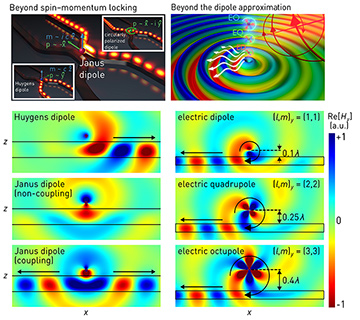 Top left: Simulation showing the directionality of dipolar sources. Top right: Artistic representation of directional multipoles. Bottom left: Near-field behavior of Huygens and Janus sources placed over a dielectric slab waveguide. Bottom right: Near-field directional excitation of guided modes from higher-order multipolar sources. [Enlarge figure]
Top left: Simulation showing the directionality of dipolar sources. Top right: Artistic representation of directional multipoles. Bottom left: Near-field behavior of Huygens and Janus sources placed over a dielectric slab waveguide. Bottom right: Near-field directional excitation of guided modes from higher-order multipolar sources. [Enlarge figure]
As with a waterwheel over a channel, in which the sense of rotation determines the flow direction, the circular motion of charges close to waveguiding structures may result in unidirectional excitation of surface or guided electromagnetic modes.1 This topological phenomenon offers a clear evidence of spin–momentum locking, underscoring the incontrovertible relationship between the transverse spin of evanescent waves and the propagation direction of guided modes. It is generally interpreted as a manifestation of the photonic counterpart to the quantum spin Hall effect.2
This universal and robust feature has enabled the observation of near-field directionality for circularly polarized dipolar sources in a wide variety of photonic platforms and spectral ranges. Yet, in work published recently, we showed that by considering linear combinations of electric and magnetic dipolar sources, the near-field directionality can be extended beyond spin–momentum locking.3 This generalization led to the theoretical prediction of a new type of local source: the Janus dipole. Together with circularly polarized and Huygens dipoles, Janus dipoles form a complete set of directional sources, thus simplifying the analytical description and broadening the possibilities for engineering the near-field coupling.
Beyond their scientific interest, these dipolar sources are intended to be exploited in practical applications. This year, Janus dipoles were experimentally demonstrated using high-index dielectric nanoparticles with spectrally overlapping electric and magnetic resonances of comparable strengths.4 This showed that the apparently exotic amplitude and phase relations between electric and magnetic moments required for these theoretical dipoles are indeed experimentally feasible in simple illumination configurations.
This year, we also explored near-field directionality beyond the dipolar approximation, by considering higher-order electric and magnetic multipoles and their combinations.5 This increases the available degrees of freedom, enhances the directional contrast and spatial frequency bandwidth, and enlarges the accessible spatial range, thus providing versatility for engineering directional scattering and coupling.
We believe that superposition of electric and magnetic dipoles that experimentally achieve near-field directionality, and the theoretical possibility of combining them with higher-order multipoles, promise new avenues for miniaturized light switching and nanorouting, photonic logical circuits, light polarimetry and novel optical forces, among other applications.
Researchers
J.E. Vázquez-Lozano, King’s College London, London, U.K., and Universitat Politècnica de València, Valencia, Spain
M.F. Picardi, A.V. Zayats and F.J. Rodríguez-Fortuño, King’s College London, London, U.K.
A. Martínez, Universitat Politècnica de València, Valencia, Spain
References
1. F.J. Rodríguez-Fortuño et al. Science 340, 328 (2013).
2. K.Y. Bliokh et al. Science 348, 1448 (2015).
3. M.F. Picardi et al. Phys. Rev. Lett. 120, 117402 (2018).
4. M.F. Picardi et al. Light Sci. Appl. 8, 52 (2019).
5. J.E. Vázquez-Lozano et al. Phys. Rev. Appl. 12, 024065 (2019).
